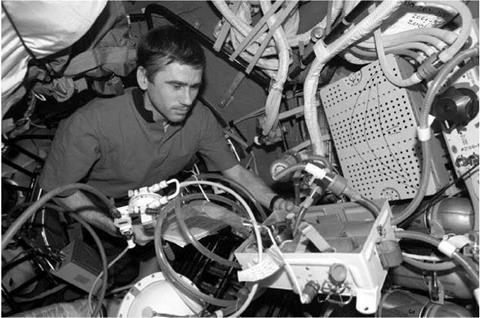EXPEDITION-7
Malenchenko and Lu began their official increment as the Expedition-7 crew following the undocking of Soyuz TMA-1. The first two days were free days, to allow them to adapt to their new home. The third and fourth days were spent on a familiarisation tour and routine maintenance. May 9 was a Russian holiday, which gave the crew another day off, even so they performed more routine maintenance and two periods of physical fitness training each.
In his pre-flight interview Malenchenko had discussed how the Expedition-7 occupation had changed following the loss of STS-107:
“Our whole program [will] be revised. Some of the things we will not do because… there won’t be any Shuttle flights to deliver consumables and the hardware. And, even the items that were originally planned to be delivered on Progress will not be delivered because Progress will be delivering something else. But, some of the scientific experiments we will do nevertheless… And, I think we will be pretty busy with science as well.’’
Asked how he expected history to view the Expedition-7 occupation Malen – chenko replied:
“It’s hard to say. I think that the tragedy that has occurred, the fact that we lost our comrades, the fact is that they gave their lives for the continued space exploration. The fact that we are together and that it’s an international project allows us to continue this effort. We have the capabilities of different countries that we can put together to continue. I think that our Expedition confirms that, shows that we continue working even in such a difficult time period.’’
In answer to a similar question he had previously replied:
“Of course, we will have fewer resources and fewer capabilities available to us. We won’t have any Shuttle flights. Originally, there were three Shuttle flights scheduled for our Expedition, and we had a lot of activities scheduled for the construction of the station. All of this has been postponed. We will use the resources that we have remaining and all our capabilities to continue. We still have our program. It looks different, but we will continue working. We will continue supporting the station. We will continue performing scientific experiments… We will be missing our third crewmember, but we realize that two people are enough to maintain the station in a working state and, additionally, to conduct work on science experiments. That’s how I see our future work.’’
Their second week on ISS began with fire and evacuation training. The crew also performed maintenance of Zvezda’s ventilation ducts, and took an inventory of Russian communication equipment on the station. Malenchenko and Lu also harvested the “Red and White’’ peas planted by the Expedition-6 crew as part of the Russian PLANTS-2 experiment. Lu worked in Destiny, servicing the experiment racks and preparing the InSPACE experiment in the MSG. The experiment studied the behaviour of magnetic particles in a fluid when subjected to a pulsed magnetic field. It was activated on May 20. As the crew completed their first month in orbit they began a series of maintenance tasks to ensure the station remained in good working order. These included monitoring the quality of the station’s internal atmosphere and the operation of the station’s LSS.
During the week ending May 30, Malenchenko and Lu replaced a faulty battery in Zvezda. They also practised donning American EMUs, inside Quest, although part of the test was cancelled when the water flow failed in the water-cooled undergarment of Lu’s EMU. With no Stage EVAs planned during the Expedition-7 occupation, the two men were practicing donning and doffing the EMUs without the assistance of a third crew member in case an unexpected situation developed that required them to complete emergency EVA. On May 30, Progress M-47 raised the station’s orbit.
On June 1, American President George W. Bush met with Russian President Vladimir Putin in St Petersburg, Russia. In a joint statement issued after their meeting Bush told journalists:
“The United States is committed to safely returning the Space Shuttle to flight, and the Russian Federation is committed to meeting the ISS crew transport and logistics re-supply requirements.’’
|
Figure 39. Expedition-7: Yuri Malenchenko works in the Soyuz TMA-2 orbital compartment. |
The President thanked his counterpart for Russia’s commitment to keeping ISS occupied and stocked with vital consumables. President Putin replied:
“Space remains a vital part of our cooperation.’’
Malenchenko and Lu both practised operating the SSRMS on June 4, grappling and releasing a target on the exterior of Destiny. The training session also served to exercise an adjustment made to the arm to improve its grappling procedure. In anticipation of the arrival of Progress M1-10, Malenchenko practised manual docking procedures with the TORU system in Zvezda.
One of the initial recommendations of the STS-107 Investigation Board was that all future Shuttle flights should be imaged while in orbit in an attempt to allow any damage to be identified and assessed. To this end Malenchenko and Lu spent June 7 calibrating and focusing a number of cameras on the exterior of ISS. In future, all Shuttles would be imaged in real time as they approach to dock with ISS. Images would be down-linked to MCC-Houston for assessment before the Shuttle was allowed to return to Earth.











